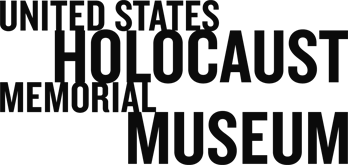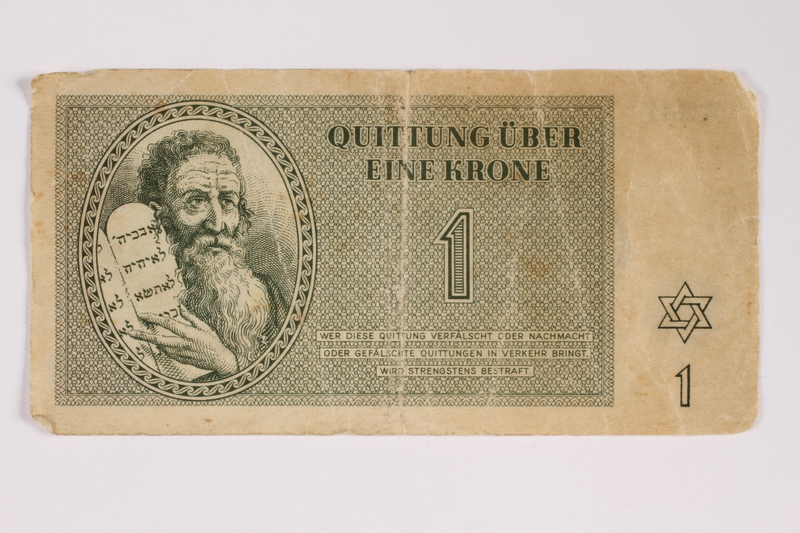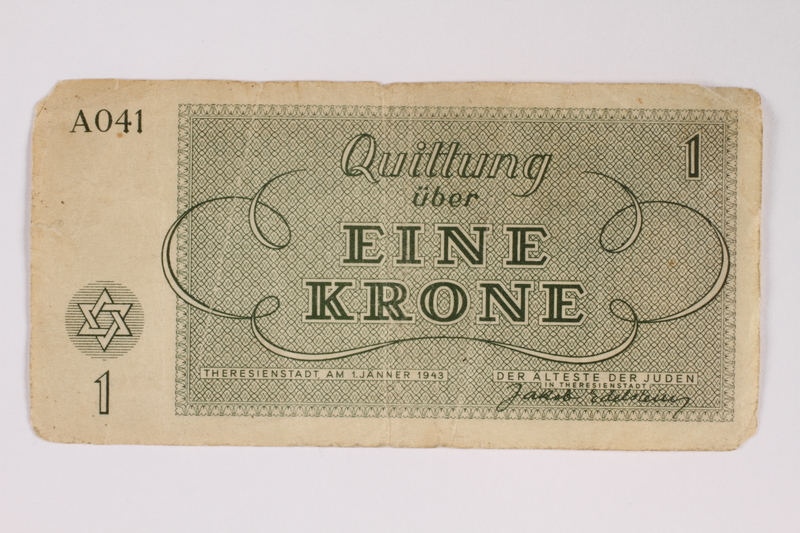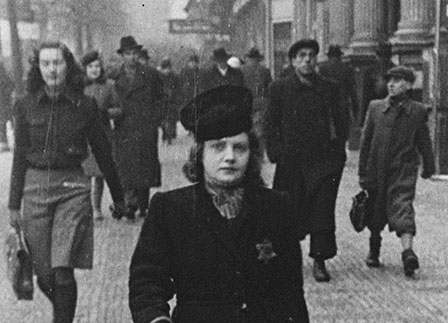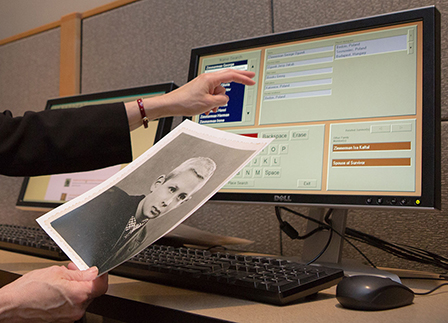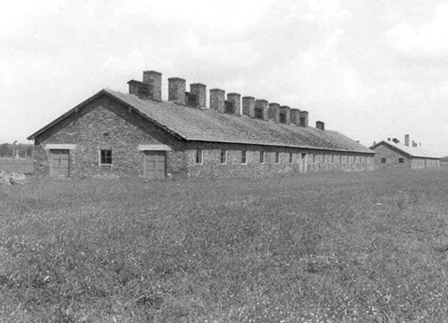Overview
- Brief Narrative
- Scrip, valued at 1 (eine) krone, of the type distributed in German occupied Czechoslovakia acquired by Gustav Meyer. Gustav was sent to safety on a Kindertransport from Germany to Great Britain ca. 1938. Inmates in Theresienstadt were not allowed to have currency. The SS ordered the Jewish Council to design scrip for use only in the camp. Notes were printed in 7 denominations: 1, 2, 5, 10, 20, 50, 100. The scrip was issued to create a false appearance of normalcy. There was little to obtain with it. The camp was in operation from November 24, 1941 until early May 1945. Approximately 140,000 Jewish men, women, and children were transferred to Theresienstadt; nearly 90,000 were then deported, likely to their death, further east. About 33,000 Jews died in Theresienstadt.
- Date
-
issue:
1943 January 01
- Geography
-
issue:
Theresienstadt (Concentration camp);
Terezin (Ustecky kraj, Czech Republic)
- Credit Line
- United States Holocaust Memorial Museum Collection, Gift of Gustav (Gus) Meyer
- Markings
- front, lower center, green ink : WER DIESE QUITTUNG VERFÄLSCHT ODER NACHMACHT / ODER GEFÄLSCHTE QUITTUNGEN IN VERKEHR BRINGT. / WIRD STRENGSTENS BESTRAFT [ANYONE WHO FALSIFIES OR DISTORTS OR FAKES THIS RECEIPT, OR COUNTERFEITS RECEIPT, WILL BE STRICTLY PUNISHED]
front, lower right corner, green ink : 1
reverse, upper left corner, plate letter and number, green ink : A041
reverse, center, green ink : Quittung / über / EINE KRONE [Receipt / of / ONE CROWN]
reverse, lower left and upper right corner, green ink : 1
reverse, lower center, green ink : THERESIENSTADT, AM 1.JANNER 1943 DER ALTESTE DER JUDEN / IN THERESIENSTADT / Jakob Edelstein [THERESIENSTADT, ON 1. JANUARY 1943 THE ELDER OF THE JEWS IN THERESIENSTADT / Jakob Edelstein] - Contributor
-
Subject:
Gustav J. Meyer
Printer: National Bank of Prague
Designer: Peter Kien
Issuer: Der Alteste der Juden in Theresienstadt
- Biography
-
Franz Peter Kien was born January 1, 1919, in Varnsdorf, Czechoslovakia (Czech Republic), to Leonard and Olga Frankl Kien. His father Leonard was born in 1886, in Varnsdorf, and was a member of the German-speaking Jewish population in the, the Sudetenalnd, which bordered Germany. Leonard was a textile manufacturer with his own factory. Peter’s mother Olga was born in 1898, in Bzenec, Austro-Hungary (Czech Republic), to Jewish parents. After 1929, the Kien family moved to Brno. Peter enrolled at the German Gymnasium, where he excelled at drawing, painting, and writing. In 1936, he graduated and moved to Prague to study at the Academy of Fine Arts. He also attended the Officina Pragensis, a private graphic design school run by a well-known Jewish artist, Hugo Steiner-Prag.
On September 29, 1938, Germany annexed the Sudetenland. On March 15, 1939, Germany invaded Prague and annexed the Bohemia and Moravia provinces of Czechoslovakia, ruled by a Reich Protector. Jews were banned from participation in government, businesses, and organization, including schools. Peter had to leave the Academy, but continued to study at the Officina Pragensis. He also taught at Vinohrady Synagogue. In September 1940, Peter married Ilse Stranska, who was born on May 9, 1915, in Pilsen, to Jewish parents.
In late September 1941, Reinhard Heydrich, the SS head of RSHA, Reich Main Security Office, became Reich Protector. Soon there were regular deportations of Jews to concentration camps. At the end of November, Theresienstadt concentration and transit camp near Prague got its first shipment of Jewish prisoners. On December 14, Peter was transported to Theresienstadt ghetto-labor camp. He was assigned to the technical department where he worked as a draftsman and designer alongside other artists, including Bedrich Fritta, Leo Haas, and Jiri Lauscher. On July 16, 1942, Peter’s wife Ilse arrived in the camp. On January 30, 1943, Peter’s parents Leonard and Olga were transported from Bzenec to Terezin. Peter was assigned major projects by the Jewish Council that administered the camp for the Germans, such as the scrip receipts used in place of money in the camp. He secretly documented the inmate’s daily life, creating portraits and other drawings, and wrote plays, poems, and an operatic libretto. On October 16, 1944, Peter’s wife Ilse and his parents Leonard and Olga were selected for deportation. Peter volunteered to go with them. Before leaving, Peter and his family were sent to Auschwitz concentration camp in German-occupied Poland. Peter survived the selection process, soon fell ill, likely with typhus, and died at age 25 in late October 1944. His wife and parents were killed at Auschwitz. Some of the work that Peter left with other prisoners or hid at Theresienstadt survived and has been exhibited worldwide.
Physical Details
- Language
- German
- Classification
-
Exchange Media
- Category
-
Money
- Object Type
-
Scrip (aat)
- Physical Description
- Theresienstadt scrip printed on rectangular offwhite paper in black and green ink. The face has a vignette of Moses, with a long beard and wrinkled brow, holding 2 stone tablets with the 10 Commandments in Hebrew. To the right is the denomination 1 and German text. The background rectangle has an intricate latticework pattern. The right side has a wide offwhite margin with the denomination 1 below a Star of David. The reverse has a background rectangle of interlocked squares, overprinted with German text, an engraved signature, and a large scrollwork line. The denomination 1 is in the upper right corner. The left side has a wide, offwhite border with 1 below a Star of David within a lined circle. The plate letter and number are in the upper corner. The scrip is vey staied and discolored, with creases.
- Dimensions
- overall: Height: 2.000 inches (5.08 cm) | Width: 4.000 inches (10.16 cm)
- Materials
- overall : paper, ink
Rights & Restrictions
- Conditions on Access
- No restrictions on access
- Conditions on Use
- No restrictions on use
Keywords & Subjects
- Topical Term
- Child refugees--Great Britain. Holocaust, Jewish (1939-1945)--Germany. Jewish children in the Holocaust--Great Britain. Jewish refugees--Great Britain. Jews--Rescue--Great Britain. Kindertransports (Rescue operations)--Great Britain. Paper money--Czech Republic--Terezin (Ustecky kraj) World War, 1939-1945--Refugees.
Administrative Notes
- Legal Status
- Permanent Collection
- Provenance
- The scrip was donated to the United States Holocaust Memorial Museum in 2011 by Gustav Jacob Meyer.
- Funding Note
- The cataloging of this artifact has been supported by a grant from the Conference on Jewish Material Claims Against Germany.
- Record last modified:
- 2022-07-28 18:26:33
- This page:
- https://collections.ushmm.org/search/catalog/irn43908
Download & Licensing
In-Person Research
- By Appointment
- Request 21 Days in Advance of Visit
- Plan a Research Visit
- Request to See This Object
Contact Us
Also in Gustav J. Meyer collection
The collection consists of three Theresienstadt ghetto-labor camp notes, documents, and photographs relating to the experiences of Gustav (Gus) Meyer in prewar Germany and during his journey on a Kindertransport to Great Britain.
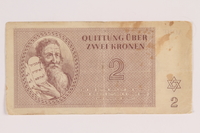
Theresienstadt ghetto-labor camp scrip, 2 kronen, acquired by Kindertransport refugee
Object
Scrip, valued at 2 [zwei] kronen, of the type distributed in German occupied Czechoslovakia acquired by Gustav Meyer. Gustav was sent to safety on a Kindertransport from Germany to Great Britain ca. 1938. Inmates in Theresienstadt were not allowed to have currency. The SS ordered the Jewish Council to design scrip for use only in the camp. Notes were printed in 7 denominations: 1, 2, 5, 10, 20, 50, 100. The scrip was issued to create a false appearance of normalcy. There was little to obtain with it. The camp was in operation from November 24, 1941 until early May 1945. Approximately 140,000 Jewish men, women, and children were transferred to Theresienstadt; nearly 90,000 were then deported, likely to their death, further east. About 33,000 Jews died in Theresienstadt.
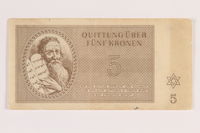
Theresienstadt ghetto-labor camp scrip, 5 kronen, acquired by Kindertransport refugee
Object
Scrip, valued at 5 [funf] kronen, of the type distributed in German occupied Czechoslovakia acquired by Gustav Meyer. Gustav was sent to safety on a Kindertransport from Germany to Great Britain ca. 1938. Inmates in Theresienstadt were not allowed to have currency. The SS ordered the Jewish Council to design scrip for use only in the camp. Notes were printed in 7 denominations: 1, 2, 5, 10, 20, 50, 100. The scrip was issued to create a false appearance of normalcy. There was little to obtain with it. The camp was in operation from November 24, 1941 until early May 1945. Approximately 140,000 Jewish men, women, and children were transferred to Theresienstadt; nearly 90,000 were then deported, likely to their death, further east. About 33,000 Jews died in Theresienstadt.
Gustav J. Meyer papers
Document
Contains fifteen photographs documenting Gustav (Gus) Meyer's experiences in prewar Germany and during his time in Great Britain on the Kindertransports, plus one undated embarkation/landing card.
